How to Make a SWOT Analysis for Marketing
To conduct a SWOT analysis for marketing, first identify your business's strengths and weaknesses, then explore external opportunities and threats in the market. Analyze this information to plan marketing strategies that leverage strengths, address weaknesses, seize opportunities, and mitigate threats.
A SWOT analysis in marketing acts like a map, providing practical insights to help you reach your goals. It shows where you stand compared to others so that you can plan smarter campaigns. Plus, by identifying areas for improvement and opportunities for growth, a SWOT analysis helps teams anticipate and manage risks, ensuring smoother marketing operations. Similar to a SWOT analysis for business, this process helps you set realistic goals and use effective tactics to succeed. Learn more in this all-in-one guide to business SWOT analysis.

“When collaboratively creating a marketing strategy, performing a marketing-specific SWOT analysis is a foundational tool that's easy for multiple people to contribute to,” explains Ryan Keiffer, Marketing and Sales Strategist at Track 2 Consulting. “We often have marketing teams each fill out a SWOT analysis, then bring them together to workshop everyone's answers and create an organizational version. This not only provides great background for the strategy, it also helps align the team and create engagement.”
A SWOT analysis is also a great starting point for streamlining processes. “Strategizing how to build on strengths, shore up weaknesses, take advantage of opportunities, and avoid threats can provide the backbone of a simplified marketing strategy,” adds Keiffer. “By looking at each element in terms of its impact, urgency, and the financial or time investment required, it becomes quite clear which marketing initiatives to focus on to create the biggest impact.”
To dive into the process of conducting a SWOT analysis for marketing, follow these essential steps. You can also use one of these free marketing SWOT templates to stay organized as you go.
- Set Clear Goals
Begin by defining what you want to achieve with your marketing efforts. This could be increasing brand awareness, boosting sales, entering new markets, or improving customer engagement.
- Gather Your Team
Assemble a diverse group for a comprehensive perspective.
“Involve team members from various departments when conducting a marketing SWOT analysis to gain diverse insights,” recommends Amanda Reineke, CEO and Co-Founder of NOTICENINJA. “This inclusivity enhances the accuracy of the SWOT analysis and ensures all potential impact areas are covered. In our experiences, this multidisciplinary approach has led to more holistic marketing strategies that address both customer and business needs effectively.”
- Identify Strengths
List internal attributes that give your business an edge, such as strong branding, unique marketing skills, or robust customer relationships.
Consider using these questions to guide a brainstorming session. You can adapt the questions so that they fit your analysis goals:
- Do you have a unique selling proposition or competitive advantage?
- How effective is your marketing team in reaching and engaging your target audience?
- What successful activities or campaigns have you implemented?
- How do you differentiate yourself from competitors in terms of brand perception and customer satisfaction?
- What resources or expertise do you have that competitors lack?
- Are your marketing strategies well-defined and adaptable to evolving trends and technologies?
- Pinpoint Weaknesses
Acknowledge internal shortcomings that might hinder your market performance, such as a limited marketing budget, gaps in customer service, or outdated technology.
Use the following questions as a base to identify areas needing improvement. Remember to tailor them to suit your objectives:
- What are common customer complaints or negative feedback about your offerings?
- Where do you face challenges or inefficiencies in your marketing funnel?
- Are there areas where competitors outperform you, and what resources are you lacking to address this?
- Can you measure the return on your advertising investments, and do you have the necessary data for optimization?
- What internal limitations or constraints hinder your marketing effectiveness?
Explore Opportunities
Look externally for potential growth areas, trends, or changes in consumer behavior that your business can capitalize on.
You can use these questions to explore potential areas for growth and enhancement. Customize them to align with your analysis:
- What external changes or trends could create new opportunities for your business?
- How can you enhance your marketing funnel or user experience to improve customer engagement?
- Which marketing channels have shown unexpected success, and how can you capitalize on this?
- Are you maximizing the potential of your budget, tools, and human resources?
- Who are your most enthusiastic brand supporters, and how can you leverage their influence?
“In the steps of a marketing SWOT analysis, I view identifying opportunities as crucial. This step not only explores new areas for expansion but also aligns with innovation strategies to outpace competitors,” says Reineke. “In our experience, pinpointing opportunities within regulatory changes enabled us to proactively update our software, offering updated solutions to our customers before our competitors.”
Assess Threats
Identify external challenges, including competition, market changes, or regulatory issues.
The following questions can help you evaluate potential risks and challenges. Adjust them to address threats that are specific to your analysis:
- Are you prepared for emerging marketing and technological changes?
- How might economic or market trends impact your industry or target audience?
- What are competitors doing that could pose challenges or disrupt your market position?
- Do you anticipate shifts in consumer preferences or technological advancements that could impact your performance?
- Are there any market shifts or expansions by competitors that could threaten your market share?
When listing your strengths, weaknesses, opportunities, and threats, make sure that your items are based on tangible data rather than assumptions. Find qualitative and contextual information from sources such as these:
- Competitor research
- Customer surveys, reviews, and feedback
- Employee surveys and interviews
- Field intelligence and customer relationship management (CRM) data
- In-house analytics, including campaign data
- Market trends analysis and industry benchmarks
- Marketing blogs and industry news reports
- Develop Actionable Strategies
Create specific strategies based on your SWOT analysis. Use your strengths to exploit opportunities and mitigate threats while addressing weaknesses.
“When working on your strategy, think of the marketing SWOT analysis output as a way for companies to determine their market standing. In one study on vehicle testing equipment markets from the Blekinge Institute of Technology, researchers found that for some companies, “it may be difficult to find and invent new marketing concepts. The easiest way for such companies to succeed is by attacking competitors´ weaknesses while protecting their own strengths.“
- Implement and Review
Execute your strategies and periodically revisit your SWOT analysis. Update it with new data and market trends to ensure ongoing relevance and effectiveness.
By starting with clear goals and incorporating metrics, your marketing SWOT analysis becomes a powerful tool for strategic marketing planning.
“The use of marketing SWOT analysis is paramount in decision-making processes because it offers a comprehensive view of the internal and external factors impacting marketing performance,” explains Nicole Dunn, CEO and Founder of Dunn Pellier Media, Inc. “By understanding our strengths and weaknesses, we can capitalize on our advantages and address any limitations proactively. Similarly, identifying opportunities allows us to use market trends and consumer insights to drive growth, while recognizing threats helps us anticipate challenges and mitigate risks.”
For helpful resources to help you complete these steps, see these SWOT analysis templates for any business or project. Also check out these industry analysis templates and competitive analysis templates to enhance your analysis of external factors.
Marketing SWOT Analysis Examples
Whether you’re assessing marketing departments, improving plans, making strategies, entering new markets, or dealing with mergers, a SWOT analysis can help you make smart decisions. Check out these downloadable examples to see how SWOT analysis can guide your marketing efforts.
Marketing Department SWOT Analysis Evaluation Example
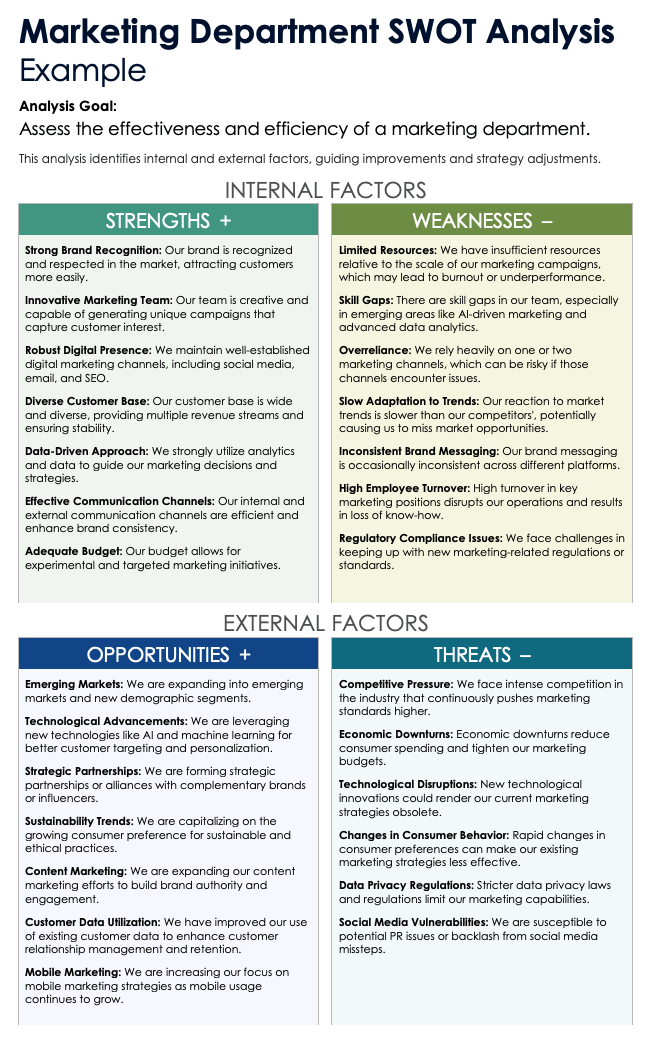
Marketing Department SWOT Analysis Example for Microsoft Word
In this example, see how a team can use a SWOT analysis to evaluate a marketing department. At the top of the page are internal factors: strengths, such as strong brand recognition and an innovative marketing team; and weaknesses, such as skill gaps and high employee turnover. At the bottom are the external factors: opportunities, such as emerging markets and technological advancements; and threats, such as competitive pressure and economic downturns.
Marketing Plan SWOT Analysis Example
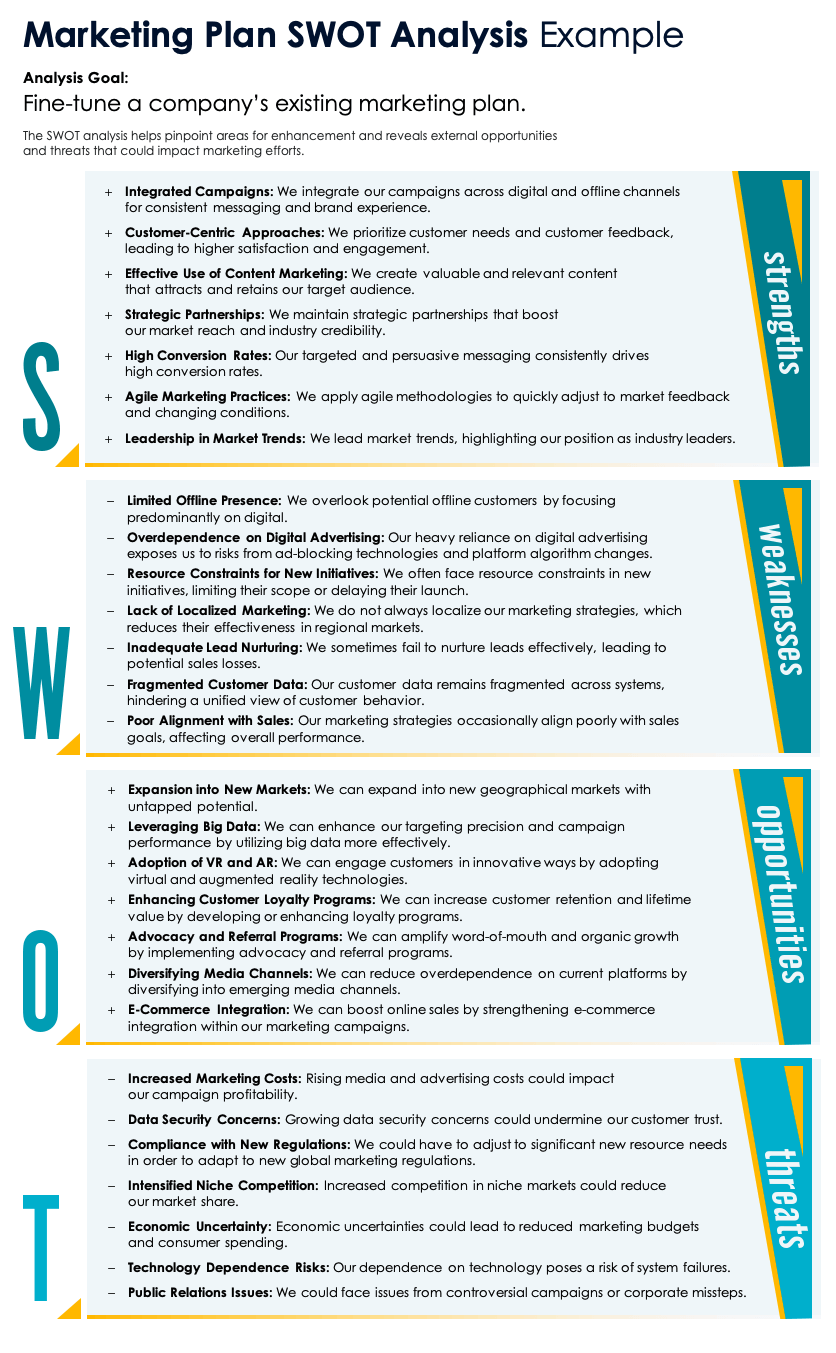
Download the Marketing Plan SWOT Analysis Example for Microsoft Word
In this example, a team conducts a SWOT analysis as part of a company’s efforts to fine-tune an existing marketing plan. This analysis uncovers strengths (such as integrated campaigns across digital and offline channels), as well as weaknesses (such as limited offline presence). The example also includes opportunities (such as expansion into new markets) and threats (such as increased marketing costs and data security concerns).
Shaping a Marketing Strategy Example
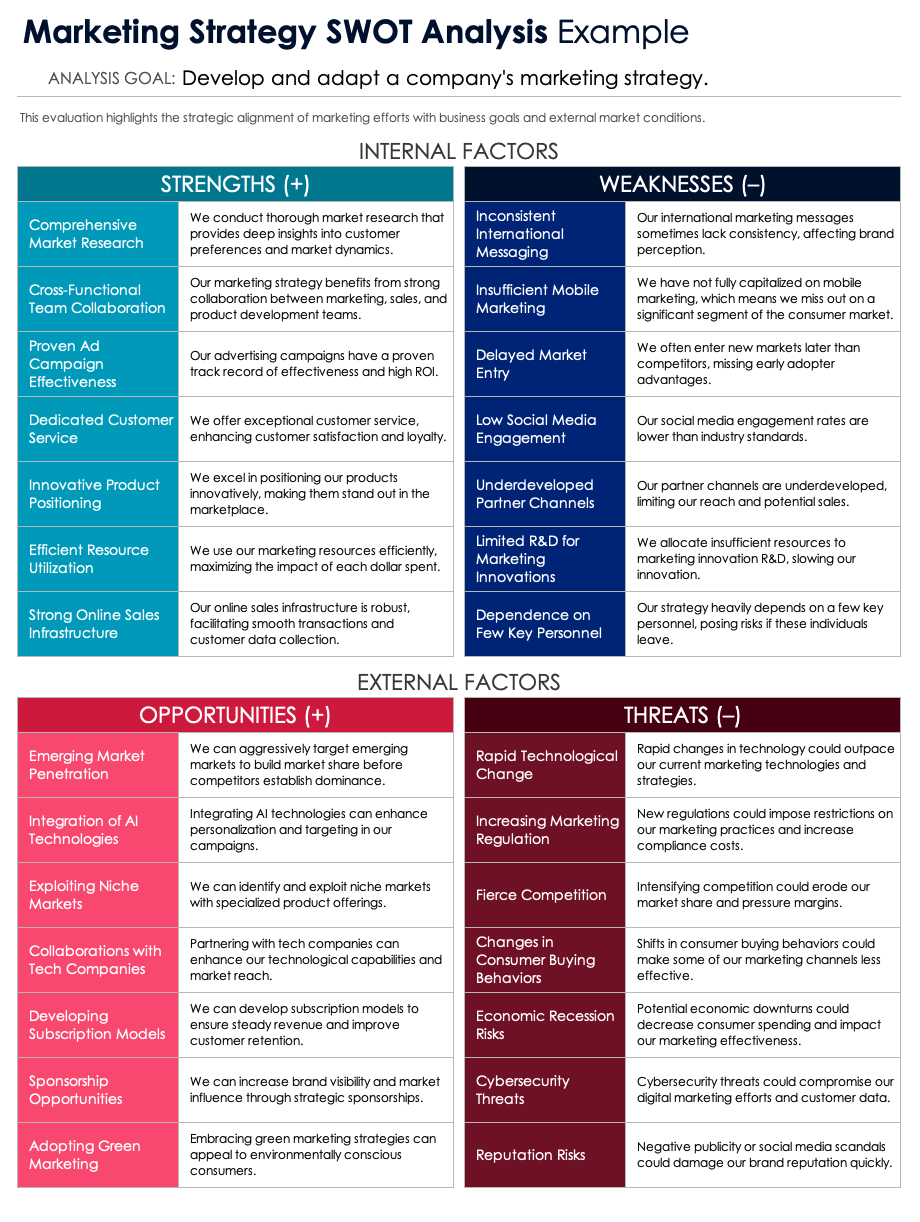
Download the Marketing Strategy SWOT Analysis Example for Excel
In this example, a team uses SWOT analysis to develop and adapt the company’s marketing strategy. The analysis highlights strengths such as cross-functional team collaboration, as well as weaknesses such as inconsistent international messaging. The example also identifies opportunities such as emerging market penetration and integration of AI technologies, along with threats such as increasing marketing regulation.
Entering New Markets Example
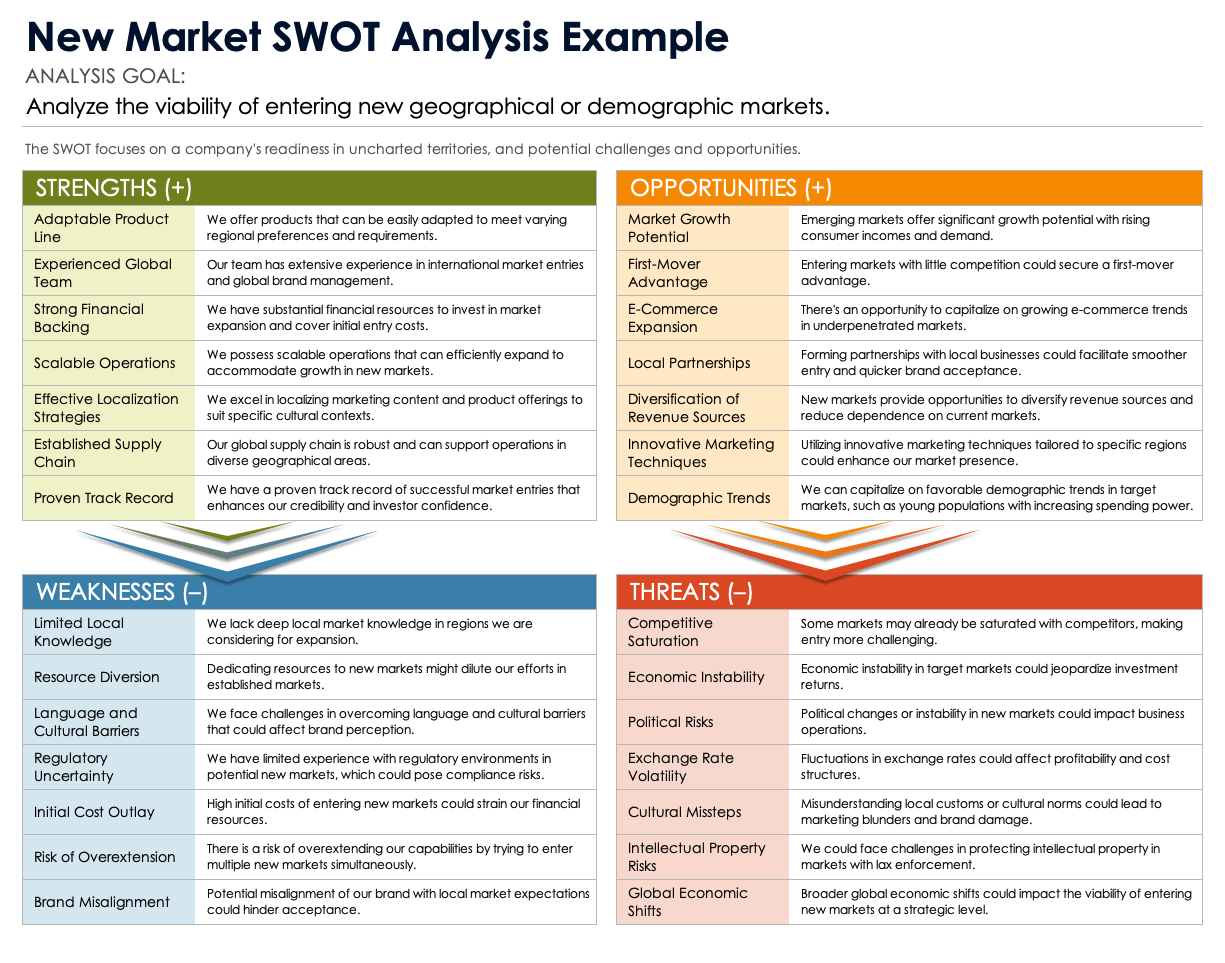
Download the New Market SWOT Analysis Example for Excel
This is an example of a SWOT analysis conducted to assess the viability of entering a new geographic or demographic market. The analysis highlights strengths such as an adaptable product line and an experienced global team, and weaknesses such as limited local knowledge and regulatory uncertainty. It also identifies opportunities such as market growth potential, along with threats such as competitive saturation.
Merger and Acquisition from a Marketing Perspective Example
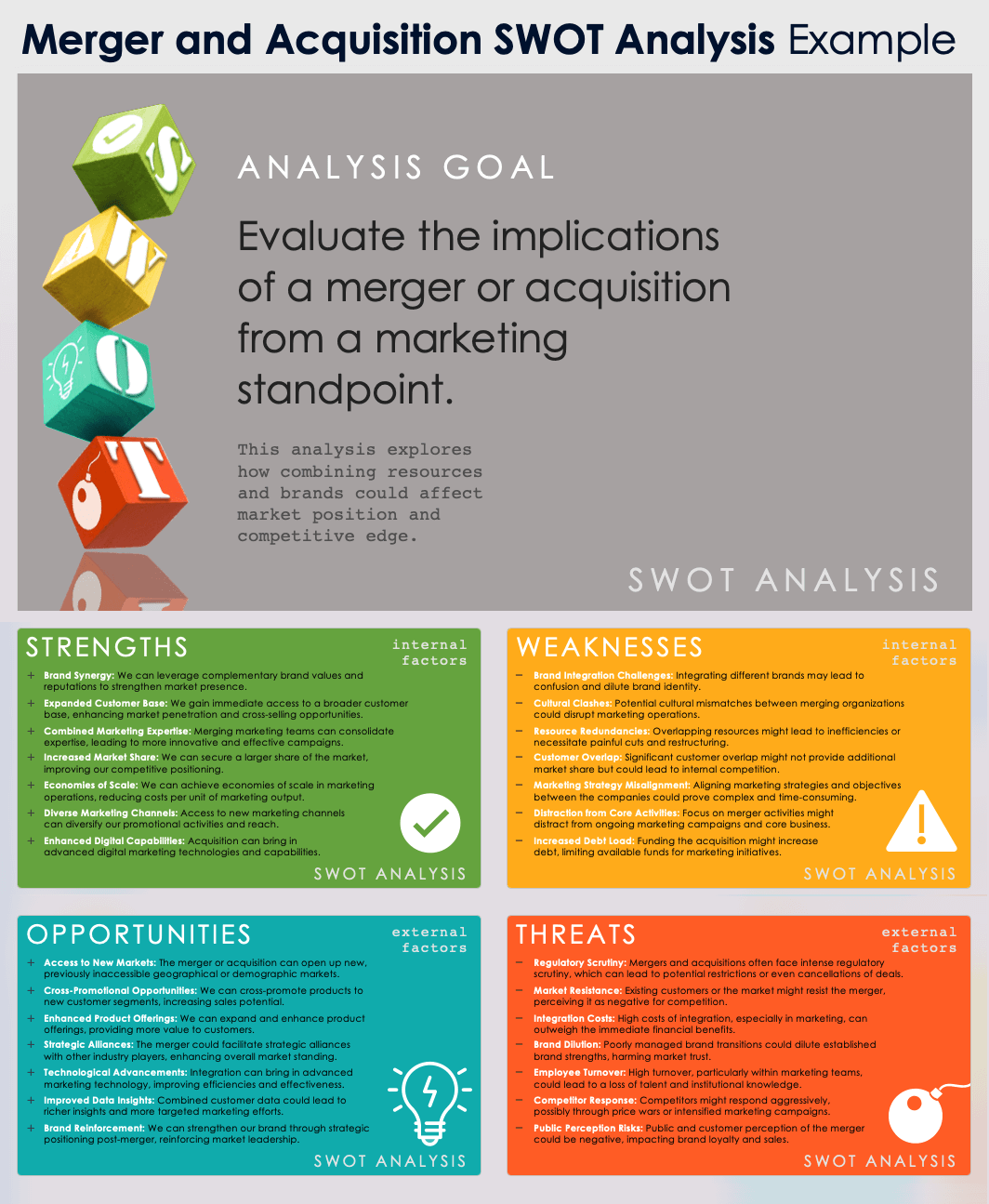
Download the Merger and Acquisition SWOT Analysis Example for PowerPoint
This example SWOT analysis is conducted to evaluate the implications of a merger or acquisition from a marketing standpoint. Strengths include brand synergy and an expanded customer base, while weaknesses include cultural clashes. This SWOT analysis also identifies opportunities such as access to new markets, and threats such as regulatory scrutiny.
Launching New Products or Campaigns Example
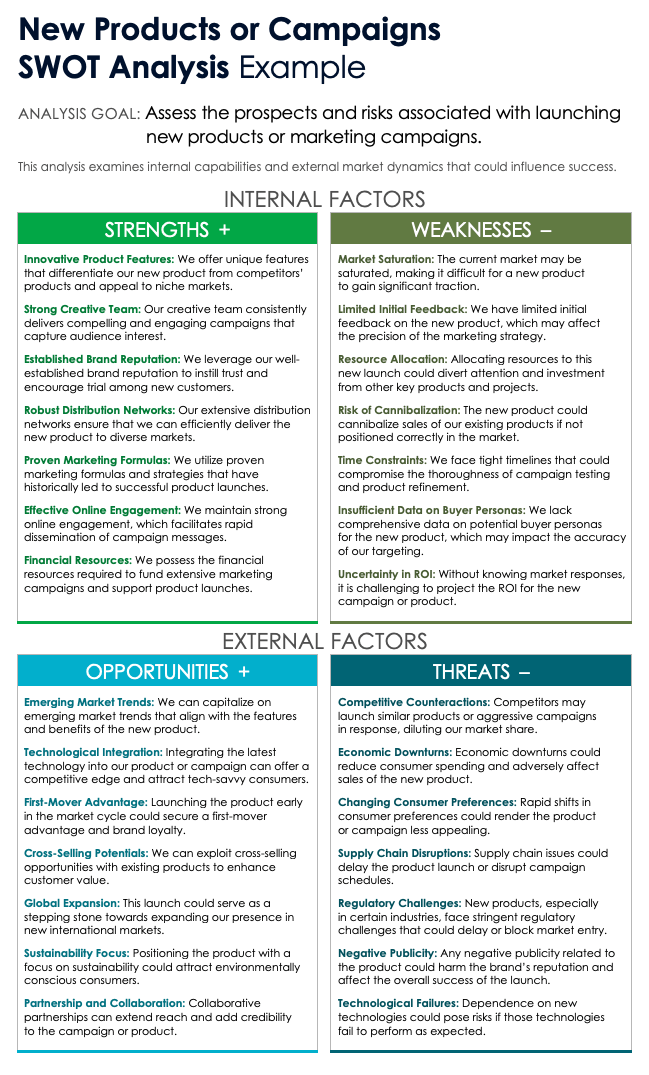
Download the New Products or Campaigns SWOT Analysis Example for Microsoft Word
In this example, a team uses a SWOT analysis to assess a new product launch or marketing campaign, examining factors that could influence success. The analysis highlights strengths such as a strong creative team, and weaknesses such as market saturation and limited initial feedback. It also identifies opportunities such as capitalizing on emerging market trends, and threats such as competitive counteractions.
Brand Reassessment or Rebranding Example
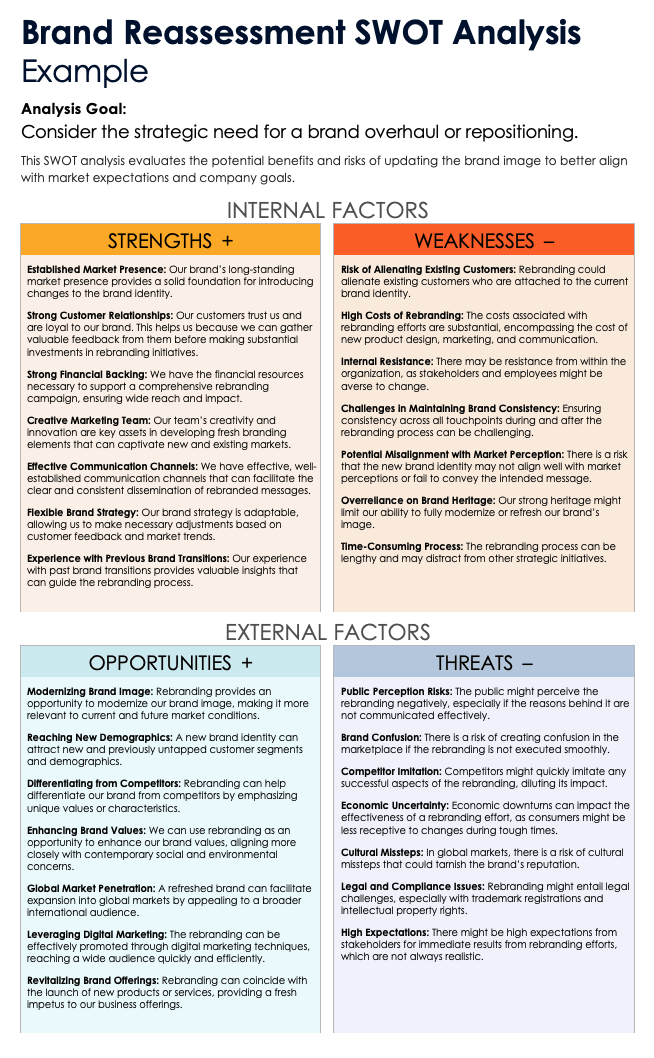
Brand Reassessment SWOT Analysis Example
This SWOT analysis example helps a team understand the potential benefits and risks of a brand overhaul or repositioning. The analysis highlights strengths such as an established market presence, and weaknesses such as challenges with brand consistency. It also identifies opportunities, such as modernizing the brand image and reaching new demographics, and threats such as brand confusion.
Best Practices for Conducting a Marketing SWOT Analysis
Best practices when conducting a marketing SWOT analysis include being honest, specific, and using real data to evaluate your business's strengths, weaknesses, opportunities, and threats. This approach helps you create effective marketing strategies that can boost your business growth.
“The most important thing about SWOTs is that they are honest reflections of your marketing situation. Sugarcoating weaknesses or threats, or inflating strengths and opportunities won't be helpful,” says Cari Jaquet, Chief Marketing Officer at Normalyze. “I always put myself in the mind of my toughest competitor when I'm creating SWOTs. What would they say we have that others don't. What are they, or the market, coming after us on.”
Here's a list of best practices for conducting a marketing SWOT analysis:
- Be Honest and Objective: Accurately assess your company’s strengths and weaknesses without bias.
- Involve Diverse Perspectives: Include input from different departments and stakeholders for a well-rounded view.
- Research Thoroughly: Back up your analysis with market research and data.
“For as much of it as possible, back up your analysis with data,” explains Jaquet. “If you are losing market share in a segment because pricing is wrong, provide data that shows it. If your brand awareness has increased in the last two years, be ready to explain how you know that and why it happened. That helps keep this about analysis, not just gut feelings. Remember you’re doing the analysis so you can build your marketing strategy and plans against current reality and expected future state. If you treat it like a scorecard, there's a risk that you'll avoid bad news or up the hype factor, which could diminish the value of the analysis and, ultimately, reduce the impact of your future plans.”
- Identify Clear Opportunities and Threats: Look at external factors, such as market trends, competition, and economic conditions.
- Prioritize Items: Not all points in your SWOT are equally important, so prioritize them based on their impact.
- Keep It Simple and Focused: Avoid overcomplication; keep your SWOT analysis concise and to the point.
- Regularly Update Your Analysis: Market conditions change, so regularly update your SWOT analysis to stay relevant.
- Use SWOT for Strategic Planning: Integrate the findings into your marketing strategy and broader business planning.
- Set Actionable Goals: Use the insights from your SWOT analysis to set specific, actionable goals.
Following these best practices will ensure your marketing SWOT analysis is effective, relevant, and useful in strategic planning.
Properly applied, “SWOT analysis identifies strengths, weaknesses, opportunities, and threats for organizations to assist in making strategic plans and decisions. SWOT is a simple but comprehensive way to assess positive and negative forces inside and outside the organization. This can help the organization to be better prepared to act effectively,” concludes a research paper on formulating business development strategies published in the International Journal of Innovative Science and Research Technology.
You can also consider additional tools to complement and further enhance your marketing SWOT analysis. See this article on market gap analysis to learn about another technique to guide your marketing strategy.
Mistakes to Avoid When Doing a SWOT Analysis for Marketing
When doing a marketing SWOT analysis, avoid relying on guesses instead of real data. Be cautious of overestimating strengths or minimizing weaknesses, and involve a diverse group for comprehensive insights. Also remember to regularly update your SWOT analysis.
“The biggest mistake we make when doing SWOT analysis is doing the work in our own little echo chamber. It's easy to reflect just the things we believe about our marketing,” says Jaquet. “The best way to keep it real is to reach out to customers, your field teams, partners, and analysts. Ask them their opinions. In fact, show them your SWOT draft and ask them for honest feedback. You'll end up with far better analysis, which will lead to better decisions about where to double-down efforts, what dangers to plan for, and what areas you can exploit.”
According to Dunn, you should stay away from the following issues if you want to succeed in your marketing SWOT analysis: “Overlooking external factors can result in a biased or incomplete analysis, so it's crucial to research market trends, competitor actions, and regulatory changes,” she says. “Failing to prioritize findings and turn them into actionable strategies can lead to a lack of direction and wasted resources. Conducting the analysis without input from relevant stakeholders can limit its effectiveness and relevance. Lastly, neglecting to regularly review and update the SWOT analysis can result in outdated insights and missed opportunities for optimization.”
Here's a list of common mistakes to avoid when conducting a marketing SWOT analysis:
- Lacking Objectivity: Personal biases can skew your analysis; strive for objectivity. Involve a diverse group of stakeholders in the SWOT process to provide different perspectives and challenge assumptions. Encourage open discussion and debate to ensure a balanced and unbiased assessment.
- Relying on Assumptions: Avoid basing your analysis on guesswork rather than actual data and research. Conduct surveys, gather customer feedback, and analyze market trends to inform your assessment.
- Ignoring External Factors: Don’t overlook external elements such as market trends, competition, and economic changes. Stay informed about industry developments and conduct regular environmental scans to identify potential opportunities and threats.
- Neglecting Small Details: Even the smallest weaknesses or threats can escalate over time and impact your marketing efforts significantly. Take proactive measures to address these issues early on, preventing potential complications down the line.
- Being Overly General: Specifics matter, so make sure you avoid vague descriptions in the analysis. Provide specific and concrete examples to support your points.
- Not Creating an Action Plan: After completing your SWOT analysis, develop a clear action plan outlining the steps needed to capitalize on strengths, address weaknesses, seize opportunities, and mitigate threats.
Avoiding these mistakes will help ensure your SWOT analysis is accurate, relevant, and valuable for informed decision-making in marketing.
Boost Marketing Operations with Real-Time Work Management in Smartsheet
Empower your people to go above and beyond with a flexible platform designed to match the needs of your team — and adapt as those needs change. The Smartsheet platform makes it easy to plan, capture, manage, and report on work from anywhere, helping your team be more effective and get more done. Report on key metrics and get real-time visibility into work as it happens with roll-up reports, dashboards, and automated workflows built to keep your team connected and informed. When teams have clarity into the work getting done, there’s no telling how much more they can accomplish in the same amount of time. Try Smartsheet for free, today.


